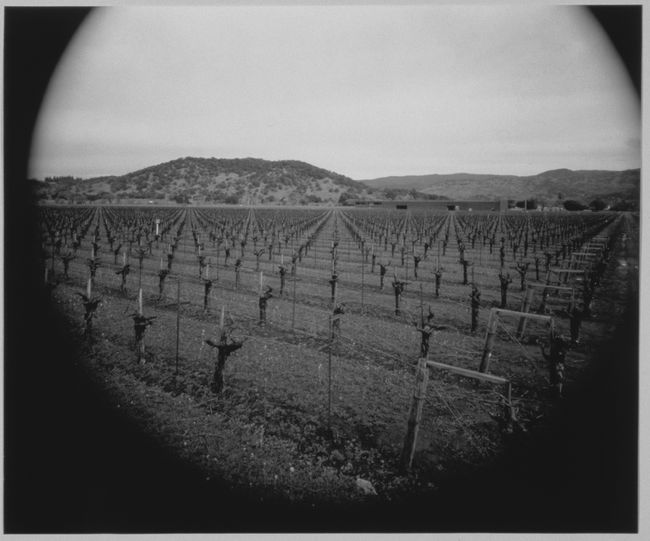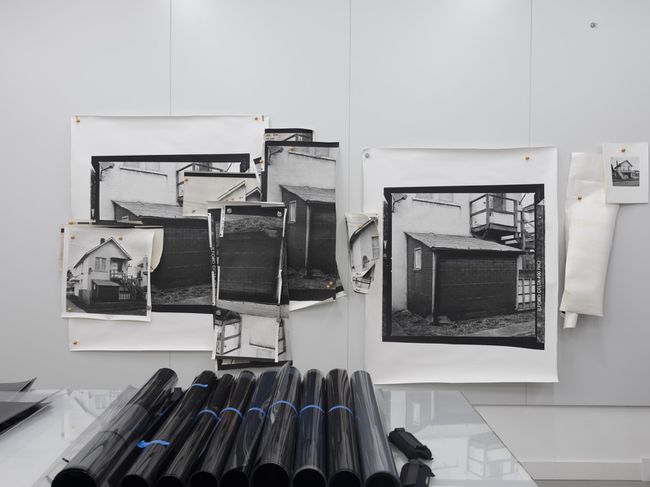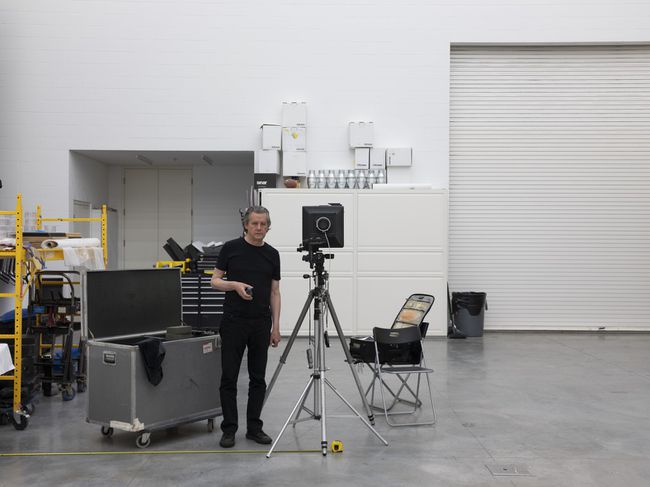Near Documentary
Jeff Wall in conversation with Stefano Graziani and Bas Princen
This oral history was filmed by Jonas Spriestersbach in December 2022 at Jeff Wall’s studio in Vancouver. It is part of the CCA project The Lives of Documents—Photography as Project, an open reflection on how past and contemporary image-making practices serve as critical tools to read our built environment and design today’s world.





- SG
- How did your photograph of the Herzog & de Meuron Dominus Winery at Yountville end up in the CCA Collection?
- JW
- The CCA commissioned the photo in 1996 or 1997. They were interested in the architecture of the winery and thought I could do something interesting. My process was very simple. People have the impression that everything I do involves some elaborate, artificial process. In this case, I went to Napa with my 8 × 10 camera, found the right place for the picture, and photographed the scene for two or three days. I decided to visit in winter because it seemed like the vineyards would be more striking without the cover of foliage—you could better see the fields’ layout and the geometry of their perspective. As usual in my work, I aimed to produce one picture that would sum up something about the relationship of the building to the land, wine, and seasons.
I didn’t plan to include the image circle in the final shot. I had photographed a synagogue in Los Angeles a couple of years prior and had discovered that the composition was much improved by letting the image circle show there. I think I was encouraged to do so to reveal how the geometry of rectangular buildings relates to the curvature of the camera lens. At the Yountville winery, the linearity of the building and the perspective of the vineyard contrasted well with the image circle. - SG
- It seems as if you photographed from a spot where the architecture almost disappears and transforms into an image of the landscape.
- JW
- Maybe, but I knew I would make the print big enough so that the building is visible and in sharp focus when you stand in front. I want my pictures to be the right size for the subject. When I surveyed the vineyard area, the view became more interesting the further I was from the building. It revealed itself so much more emphatically because of the receding perspective of the rows of vines. I was compelled backwards by the setting.
Dominus Winery, Yountville, Napa Valley, California, United States, 1999
Life of the Project
1998–1999
Commissioned by the CCA for the Herzog & de Meuron: Archaeology of the Mind exhibition, Wall first visits the site in the summer of 1998 and returns in February 1999 to shoot the photograph in winter
2000
Acquisition by the CCA, Montréal, Canada, of a silver gelatin print (PH2000:0649), donated by Seagram Chateau & Estate Wines Company, owner of the Dominus Winery. An edition of 3, the other two are held by the Helga de Alvear Collection in Madrid, Spain, and in a private collection in the USA
2001
Exhibition: Jeff Wall
Organized at Galleria Helga de Alvear, Madrid, Spain
18 January – 2 March 2001
2001
Exhibition: Minimalismos
Group exhibition by the Museo Nacional Centro de Arte Reina Sofia, Madrid, Spain
10 June – 8 October 2001
2002
Exhibition: Herzog & de Meuron: Archaeology of the Mind
Organized by the CCA, Montréal, Canada
23 October 2002 – 6 April 2003
2002
Publication: Herzog & De Meuron: Natural History / Herzog & de Meuron: Histoire naturelle / Herzog & de Meuron: Naturgeschichte
Published by Lars Muller, Zurich, Switzerland; edited by Philip Ursprung
2004
Publication: Pictures of Architecture – Architecture of Pictures: A Conversation between Jacques Herzog and Jeff Wall, moderated by Philip Ursprung
Published by Springer, Vienna, Austria
- SG
- You have a reproduction of a photo by Dan Graham in your studio, a former collaborator whose work will also be in our exhibition. How do you describe his photographic approach, and how does it compare to yours?
- JW
- I can’t think of someone whose work is more unlike mine. Dan called photography a hobby, one among many things he did, and he wasn’t very interested in photographic technique. Photography was more of a notational thing for him—he used the camera to make mental notes about other projects. But I think he had a pretty sharp idea of what he wanted to do and an interesting way of looking at things. You must be a certain kind of person with a certain sense of self to see things in an unusual way—he could do that. His work also proved you don’t need much skill to succeed in photography, because while he didn’t have much skill, he didn’t want or need it.
- BP
- Your works are closely tied to their site and Vancouver. Do you wander and return to the same spot, only to see something even better? Often, the thing behind my back is more interesting than the topic that had initially interested me.
- JW
- I don’t necessarily start a project by physically going anywhere. I could find a starting point by reading or remembering something. I just finished a picture of a woman falling from her horse, a subject recommended thirty years ago by somebody who had seen that happen and thought it would make an interesting photo. I forgot about this suggestion, and then it came back to me out of the blue. I didn’t have to move out in the world to find the trigger for the work, but I had to start moving about once I decided to do it to places where I could find horses. But I do go out to hunt for photos, too. I’ve frequently said that, like other photographers, I walk around to search for possibilities but rarely photograph anything. Much of the time, I wait for things to drift toward me.
- SG
- Your photos can be classified into many categories: documentary, almost documentary, cinematographic. Has the documentary characterized your work at certain moments in your career, or has the documentary always been part of your projects?
- JW
- I don’t think that my use of the documentary manner follows any defined ebb and flow. Any inflection, no matter how minor, from what everybody calls the documentary mode becomes a form of cinematography. So, the “near documentary” is cinematographic because it’s not fully documentary. When I made this distinction in the first comprehensive catalogue published on my work fifteen years ago, some people said I had confused the issue. I pushed back against that because my work came to public attention in the 1980s for having more to do with artifice than was previously considered desirable or even possible. One of the misconceptions then was that I was doing something entirely different in photography. And, sure, my work was different, but I never aimed to critique “classic” photography. I only felt that dimensions of the technology and medium weren’t being explored, like colour, scale, and the potential to develop a new pictorialism more devoted to the picture than the subject or social context. I saw a space for picture-making in photography but considered this approach as expanding upon, rather than opposing, the documentary.
I’ve never liked when people put one mode of making art against another, assuming that one approach is inherently superior to another—it always seems like a limiting way to approach any art form. And because of that, I never resisted engaging in reportage when it suited me. I like my pictures to weave together different elemental categories of photography. For me, the tableau was the foundation of that process. Within that framework, all the old rules of photography changed—the possibilities of artifice and reportage were no longer isolated.


